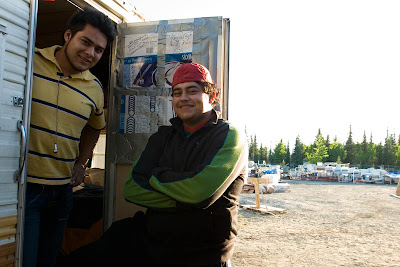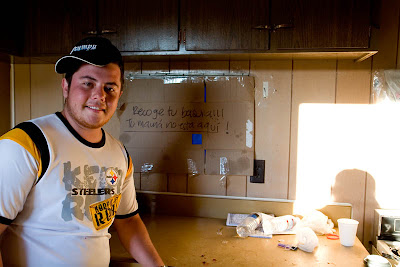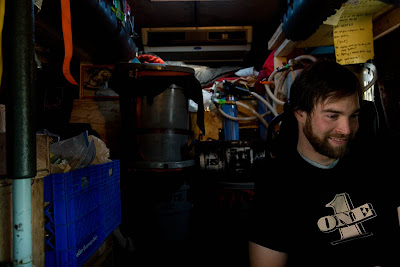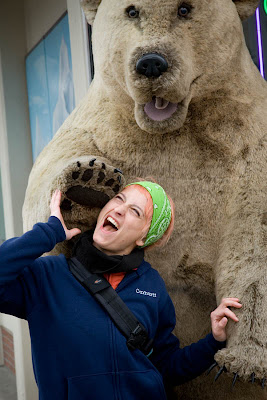This is part of that hindsight. With 5 months and almost 5000 miles between us, I can look back and appreciate my time at Snug Harbor.
With that in mind, here’s the story of a typical day at Snug Harbor. All photos are thanks to the relentless dedication of Laura Webb. Not only did she join us to document our tour to Alaska, but continued on to work alongside us in the cannery and capture this unique part of our trip- for better or worse.
The full photo journal from the cannery is available here:
 |
| Snug Harbor |
The people involved in this experience got here by means of their creative projects. You can check out what brought us to Alaska here:
Mose Giganticus
The Emotron
The Music Underground
WAKE UP!
A typical day would start at 6:45am with a cell phone alarm going off in our ears. We were living in our bus parked in the lot of the cannery. The roof would be leaking from the relentless rain overnight. As luck would have it, this was the rainiest Alaskan summer in the past 53 years. It’s 50 degrees, damp, and cloudy. We’ve got 30 minutes to get some bad coffee, plain oatmeal, and suit up for work by 7:15. Or I could hit the snooze button and skip breakfast…

CLOCK IN!
Usually by 7:15, the workers are gathering in line to clock in and start what may turn into another 20 hour work day. It all depends on the catch last night and we won’t know until we’re elbow deep in guts. The first to clock in has dibs at the community gear rack, which if you’re lucky, means bibs that fit AND have no holes! The early bird gets a drier, slightly warmer work day. Slow pokes end up with wet clothes. So let’s suit up and get on the line! (Don’t forget your beard net, MATT!)



THE LINE!
The cannery warehouse is quiet and sterile before the day’s work begins.


Less than 5 minutes after clocking in, the line explodes into action- with messy results. It won’t take more than 30 seconds before you’re covered in blood and guts. Everything you’re wearing will somehow, someway get fish parts on it. The clothes you wear to work are sacrificed to the cannery- you’ll never be able to wear them again without the permeating stench of dead fish. As a result, most people wear the same thing everyday, never bothering to wash it. You get used to it.

Everyone has a job to fill on the line. It only takes a minute or two to get the hang of your special position to fill. The hard part is finding a way to maintain the short repetitive motions for a 16-20 hour day without going numb. That takes technique, which is developed over time. During my time at Snug, I worked just about every position at the “head” of the line – feeding the header, heading (briefly), boring, belly slicing, gutting, and feeding the line. So now, let’s go down the line a bit…
The salmon are dumped out of totes, fresh from the docks, 1000 lbs. at a time. First, they are headed with this larger mechanical guillotine…

…which quickly makes a large pile of fresh fish heads (that can be sold for $.50/lb to make dog food!)

Did you get all that?

After their heads are off, the fish are gutted by inserting a small knife into the anus and slicing up the belly until you hit the opening where the head used to be. Then, simply run your fingers down the inside of the fish and guts come out- simple as that. The fish guts are just about the only fish matter that isn’t sold to market, but they’re working on a way to fix that. Don’t worry though, it doesn’t go to waste- when this gets dumped, the seagulls have a field day!



Another important job of the gutter is to separate the egg sacks from the guts of the female fish. The salmon eggs (or roe) are THE most valuable part of the fish. The revenue from roe alone pays the entire operating cost of the cannery, including our wages. The salmon meat and everything else the cannery produces is pure profit. The roe is collected in baskets and taken to a designated “roe room” where it is washed, graded for quality, and packaged. This is a very specialized area and not a place for beginners. I don’t think I ever even spoke with a roe room worker- it’s an exclusive club.




Back to the line… the gutted fish are placed on a conveyor belt and systematically cleaned by a fleet of about 30 workers. As the fish move down the line, the now-gutless cavity is scraped and rinsed repeatedly to remove the rest of the unfavorable remains which pile up on the floor until the end of the workday.


(Yes, that’s blood.)
At the end of the line the fish are separated and graded by weight and quality

Some of the fish are racked and frozen for later use, the rest is sent to “Fresh Pack.”


FRESH PACK!
On the other side of the cannery, opposite the line, there lies a small splinter-cell of rouge workers who seem to operate independently of the line. We are FRESH PACK! As you may have guessed, Fresh Pack is where I spent the majority of my time at Snug. As the name suggests, fresh pack prepares the fresh fish for shipment across the world. My responsibilities were to weigh out orders of several thousand pounds of salmon in precise 50 lb increments and to keep the orders flowing smoothly. Speed and precision were essential.


We mostly packed salmon coming directly from the line, but we also got to handle odd and oversized fish- that was the most fun!




CLEAN UP!
At the end of the day, when we’ve gutted, cleaned, packed, and shipped the last fish on the property, we get to clean the monumental mess left behind. It seems like it would be the last thing you’d want to do at the end of a day like this, but it’s a welcome change of pace AND the last step in clocking out for the day!


SNUG LIFE!
Though the days were typically 16+ hours long, in the span of a month we would get the occasional mere 8 hour day, or even a day off if the weather kept the fishermen from making a catch the night before. During these rare and fleeting moments, we got to explore Snug Life.
Living conditions on the Snug grounds were not comfortable. Some of the people working with us had been in foreign military boot camp, prison, or both. The general consensus was that living conditions at Snug were better than prison, but worse than boot camp.
Those of us who were lucky enough to drive to Snug lived in our vehicles. Those who flew in from other countries lived in run down trailers or tents. Most knew what they were in for and tried to make the best of it…


On our first day, we met our fast friends Mario, Leon, and Alejandro who invited us into the luxurious trailer they shared.


If you weren’t too busy sleeping, eating, or going to the bathroom on your day off, you could enjoy the amenities of the vacant lot, or basketball shack.


All things considered, we had it pretty good inside the bus.

But no matter how you spend your limited down-time, it wouldn’t be long before you were back on the line. In the end, as the Snug saying goes, “It’s all about the fish!”

And as we learned driving up here- always keep your wits about you and never forget YOU’RE IN ALASKA! Stay safe!
